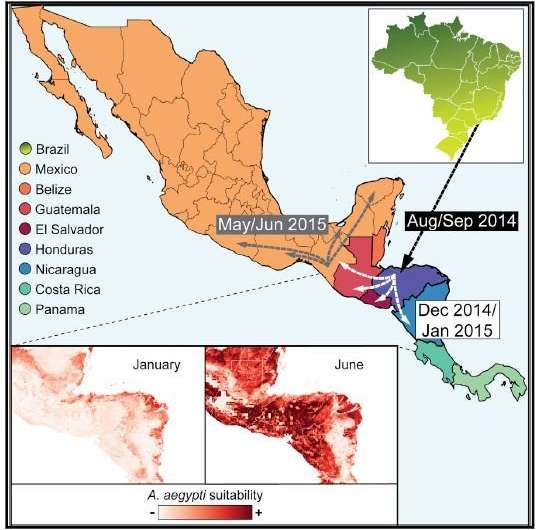Reconstructing Zika's spread

The urgent threat from Zika virus, which dominated news headlines in the spring and summer of 2016, has passed for now. But research into how Zika and other mosquito-borne infections spread and cause epidemics is still very active. In a paper published May 24 in the journal Cell Host & Microbe, an international team of researchers reports new details of how Zika emerged from Brazil and spread throughout Mexico and Central America, with evidence that some locations had more than one outbreak.
The study has implications for detecting and monitoring future epidemics of mosquito-borne viral disease. It also highlights the need for better collection of data linked to distinct geographic regions within countries.
"In this study, we were able to reconstruct in detail how Zika was introduced and spread throughout this region," says senior author Oliver Pybus, a professor of evolution and infectious disease at University of Oxford and one of the study's senior authors. "By looking at the genomes of Zika viruses obtained from people who had been infected, we discovered a surprising amount of information about the epidemic's transmission history."
The researchers obtained full or partial sequences of the Zika virus genome from clinical samples, such as blood and urine. Using data obtained from the viral genomes, the researchers made two important discoveries. The first was that they were able to reconstruct in more detail when and where Zika was introduced and how the virus spread throughout Central America and Mexico. The other finding is that the epidemic in many locations actually had two peaks annually that were split across more than one mosquito breeding season. (Mosquitos feed on blood—and transmit diseases—only when they are breeding.)
"What we found was not what we expected," says first author Julien Thézé, a computational evolutionary biologist at Oxford. "There is usually only one breeding season per year, but we found two separate outbreaks in a relatively small country like Honduras."
"Data about disease outbreaks is usually collected on a national level," Pybus adds. "But we found a great degree of variation in the degree to which individual locations are suitable habitats for mosquito breeding at different times of the year."
The Zika virus was first identified in the 1940s in a Ugandan macaque. It is transmitted mostly by Aedes mosquitos but also can be spread through blood transfusions and sexual contact and from mother to child. Zika was first reported in the Americas in May 2015. It gained widespread attention about a year later, due to its most devastating effect: pregnant women who became infected sometimes gave birth to babies with birth defects, especially severe microcephaly (small brains and heads).
In the current study, the researchers developed a method to not only look for and sequence Zika but also simultaneously detect other viruses that may be co-circulating in the same geographic area. "Genome sequencing approaches generally target one virus at a time," says Charles Chiu, an associate professor in the Department of Laboratory Medicine at the University of California, San Francisco, and the other senior author. "This technique provides a blueprint for how you might be able to conduct surveillance of unknown viral outbreaks in the future."
Based on the data, the researchers determined that the first outbreak in Mexico occurred earlier than it had previously been reported. Zika infections in that country were believed to have peaked in the middle of 2016, but genomic data suggested that an earlier outbreak took place in early 2015. This finding was confirmed by other published reports showing an increase in the birth of babies with microcephaly in the second half of 2015.
Zika infection is not currently considered a global public health emergency because a high proportion of people living in areas covered by the Aedes mosquito are likely to have been infected and now have immunity. But the researchers say that their findings provide important new insights about how viral pathogens spread and that the methods they developed could be widely adopted in the future to track other viral outbreaks.
More information: Julien Thézé et al, Genomic Epidemiology Reconstructs the Introduction and Spread of Zika Virus in Central America and Mexico, Cell Host & Microbe (2018). DOI: 10.1016/j.chom.2018.04.017
















